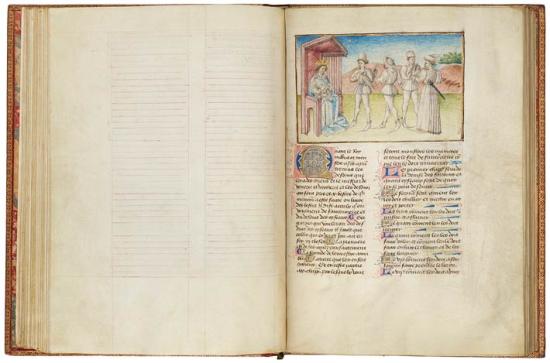
Livre du roy Modus et de la royne Racio
Illuminated by the Master of the Vienna Roman de la rose (Jean Hortart?)
Purchased, 1947
Ferrières's treatise on hunting is open to the chapter on falconry, illustrated with an enthroned King Modus instructing youths in the art of hunting with birds. The pen-and-wash medium carefully delineates the tailoring of their garments. Three young men wear the short gown with pleating that flares flatteringly both below and above the narrow waist. The slit sleeves are highly padded at the shoulders. While the youths sport the revived pouleines, two also wear loaf-shaped caps, typical of the 1460s. The hunter at right, who prefers the long gown, wears a "burlet-chaperon," headgear in which the fat burlet is permanently rolled.
Late Gothic Vertigo
In the 1460s and '70s fashions reached their Gothic climax. The look for both men and women was tall, long, and lean. Thin was in.
The look for men was dominated by the gown, worn either very short (to the crotch—or barely so) or very long (to the ground). Both versions, accented by a thin belt around a narrow waist, featured high padded shoulders and pleats that flared down over the buttocks and up over the back and chest. These features, developed during the previous decades, brought to a culmination the flatteringly masculine V-shaped silhouette. Pouleines, which accented the lean look, were revived. The chaperon, in fashion for over a hundred years, finally went out of style as new hats–especially a tall, loaf-shaped version—arrived.
Women's gowns continued with their wide V necks, high wasp waist, and long trains. For headgear, temples went out of fashion and were replaced by the turret. This cone-shaped coif, from the tip of which cascaded transparent veils, is perhaps the stereotypical ladies' hat from the late Middle Ages.
